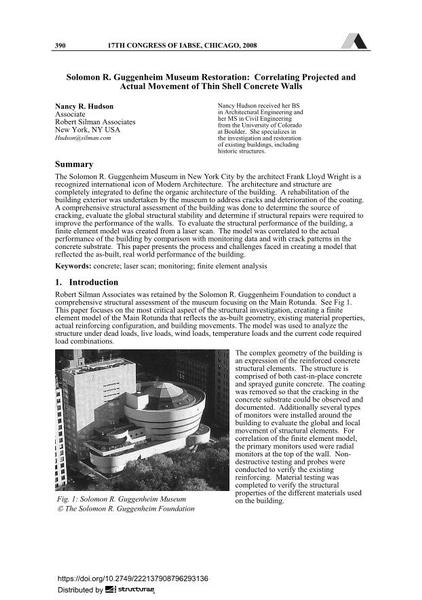Solomon R. Guggenheim Museum Restoration: Correlating Projected and Actual Movement of Thin Shell Concrete Walls

|
|
|||||||||||
Bibliografische Angaben
| Autor(en): |
Nancy Hudson
|
||||
|---|---|---|---|---|---|
| Medium: | Tagungsbeitrag | ||||
| Sprache(n): | Englisch | ||||
| Tagung: | 17th IABSE Congress: Creating and Renewing Urban Structures – Tall Buildings, Bridges and Infrastructure, Chicago, USA, 17-19 September 2008 | ||||
| Veröffentlicht in: | IABSE Congress Chicago 2008 | ||||
|
|||||
| Seite(n): | 390-391 | ||||
| Anzahl der Seiten (im PDF): | 8 | ||||
| Jahr: | 2008 | ||||
| DOI: | 10.2749/222137908796293136 | ||||
| Abstrakt: |
The Solomon R. Guggenheim Museum in New York City by the architect Frank Lloyd Wright is a recognized international icon of Modern Architecture. The architecture and structure are completely integrated to define the organic architecture of the building. A rehabilitation of the building exterior was undertaken by the museum to address cracks and deterioration of the coating. A comprehensive structural assessment of the building was done to determine the source of cracking, evaluate the global structural stability and determine if structural repairs were required to improve the performance of the walls. To evaluate the structural performance of the building, a finite element model was created from a laser scan. The model was correlated to the actual performance of the building by comparison with monitoring data and with crack patterns in the concrete substrate. This paper presents the process and challenges faced in creating a model that reflected the as-built, real world performance of the building. |
||||
| Stichwörter: |
Beton Finite-Elemente-Analyse Monitoring
|
||||
